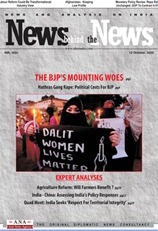South Asian nations need to harness resources to cope with pandemic fallout
South Asian nations need to work together to cope with COVID-19 and unlock new opportunities to build economic resilience, connectivity, and human capital, writes Partha Pratim Mitra for South Asia Monitor

The latest data from the International Labour Organisation (ILO) confirms that globally working-hour losses during the COVID-19 pandemic are reflected in higher levels of unemployment and inactivity, with inactivity increasing more than unemployment. The informal sector has been the worst affected due to both these factors.
It has also been observed that the decline in employment numbers has been greater for women than for men. Further, it has been estimated that about 94 percent of the world’s workers currently live in countries with some sort of workplace closure measures put in place. This share reached a peak of 97 percent on April 25, 2020, which slowly declined until mid-July, after which it began to increase slightly due to a rise in the number of COVID-19 cases.
Lockdown affects global workforce
Lockdowns of workplaces for all but essential workers (that is, the most stringent of possible measures) continue to affect a sizeable share of the global workforce. As of August 26, 2020, almost one third (32 percent) of the world’s workers were living in countries with such lockdowns. More recently, the most stringent workplace closure measures were only intended for workers in highly infected areas in countries, rather than covering a country’s entire economy.
The prevalence of the most stringent type of lockdown (required closures for all but essential workplaces) varies widely across regions. Despite the rising number of cases, stringent measures have not manifested itself in low-income countries including South Asia. This can be due to the pressure to resume work in view of the large numbers of people living in poverty who rely on jobs for their livelihoods, particularly in the informal economy.
South Asia worst affected
The data on hours lost ( i.e. % of the total, with baseline = Q4/2019, seasonally adjusted) and the number of Full-Time Equivalent (FTE) jobs lost (48 hours/week) (millions) estimated by the ILO (see figure 1) shows Southern Asia has been the worst affected as compared to other parts of Asia during the first three quarters of 2020.
Figure 1: Hours lost, and Jobs lost in different parts of Asia
![]()
Source: ILO Monitor, 6th edition
Despite early containment measures, the COVID-19 pandemic is not yet under control in South Asia. In March, South Asian countries quickly imposed lockdowns and travel restrictions, but not all countries were able to contain the domestic spread of COVID-19. The collapse in the activity was widespread in the region between March and August. Nighttime light intensity, which is one of the standard measures to gauge spatial economic activity, declined in more than three-quarters of South Asia’s districts. It is estimated that in August, the average nighttime light intensity across districts was still 10 percent below its level a year earlier.
South Asia’s informal economy hit hard
The informal economy in South Asia has been adversely affected by the COVID-19 pandemic. Many unorganized workers, self-employed people, and microenterprises have experienced a large drop in earnings. The dire situation in the informal sector has arisen as most of the service sector activities that were affected by the lockdown have the informality of work as their main characteristic.
Furthermore, many informal workers also face a greater risk of being exposed to the disease as the services which they render require close human interaction and contact. Isolated and home-based work is very often not an option for most informal workers due to the less automated nature of the work which they do. Added to this complex situation is the narrow internet penetration in the region making digital work more difficult for most of the informal sector.
It could therefore be said that the COVID-19 impact is clearly biased against informal sector workers as they have suffered the largest declines in employment, and most households which have become poorer during the pandemic are dependent on informal jobs, largely daily casual wage workers.
The overall assessment of the economic situation due to the pandemic in South Asia could be described as one of low consumption demand resulting from uncertainty in the regular flow of incomes due to job losses and inactivity.
Facing debt crisis
In South Asia, along with most parts of the developing world, the economic policy package during the pandemic is confronted with the risk of financing the fiscal stimulus with government sources of revenue drying up and possible trickling down of external finance due to an increase in risk aversion by foreign investors. There is apprehension by policy experts of a possible domestic debt crisis due to public borrowings in the absence of any strong alternative for resource mobilisation except for imposition of taxes on the super-rich.
With a fragile banking sector with high levels of non-performing assets, the revival of GDP growth could be a major challenge.
To assess if there is a domestic debt burden on the countries in South Asia, we have estimated the debt sustainability of these countries. In simple terms, debt sustainability is the ability of the governments to repay their public debt which is contracted to meet public expenditure and is measured by a comparison of the rate of growth of GDP and the rate of growth of public debt. The debt sustainability would become adverse if the rate of growth of GDP becomes progressively lower than the rate of growth of public debt.
Such a situation implies that raising resources to repay the public debt to meet public expenditure, which is generated out of the GDP, becomes increasingly for governments. The data shows that most countries in South Asia have a problem of debt sustainability and the only country which shows negative growth in public debt has very high levels of public internal debt, exceeding even the country’s GDP (see table 1 and figure 2).
Table 1: Average annual growth of GDP and public internal debt
![]()
Figure 2: Average annual growth of GDP and internal debt
![]()
Note: Real GDP growth, at constant market prices.
Source: Beaten or Broken? Informality and COVID-19 South Asia country briefs, The World bank, p108-131(figures in the table are estimated from the data)
Do we then look at the debt sustainability data and accept them as the gold standard for restraint in public borrowing even during these unprecedented and difficult pandemic times? Countries facing the pandemic and more so in South Asia will have to resolve this question amicably weighing all their options. The opinion among policy experts is clearly not on the side of over caution but given the difficult situation walk the extra mile to balance the issue of lives and livelihood so that both receive equal priority and herein lies the main challenge of matching resources with sequencing of expenditure under different government programmes on health and income-generating activities.
Spending decisions are rarely based on technical principles or on detailed work to determine the population’s preference. The allocation of funds results from a series of forces that converge at different points of the decision-making process depending upon an imperfect perception of the present and future political realities. What emerges out of such an imperfect perception is the strength of decision making by the leadership to cope up with the emerging challenges.
Need to work together
Measures announced by countries in South Asia broadly revolve around the strategy of increasing health spending including providing additional insurance coverage to all medical personnel fighting the coronavirus, importing additional medical supplies, and setting up quarantine centres and temporary hospitals or regular hospitals converted into exclusive COVID-19 facilities. Social assistance has also been strengthened by providing the most vulnerable with food rations and extending tax-filing deadlines. Informal sector workers who have lost their jobs due to the ongoing crisis has been given the opportunity to participate in the public-works project.
All these measures call for sequencing of expenditure in accordance with national priorities and better targeting of beneficiaries so that those who need the assistance get it. South Asian nations need to work together to cope with COVID-19 and unlock new opportunities to build economic resilience, connectivity, and human capital.
This underlying strategy to cope with the pandemic would need to also harness resources from global financial institutions so that the dependence on domestic borrowings is reduced and the issue of debt sustainability is also addressed without in any way affecting the resources for growth in the region.
(The writer is a retired Indian Economic Service officer who worked in the labour ministry. He can be contacted at ppmitra56@gmail.com)
References:
ILO Monitor: COVID-19 and the world of work. Sixth edition Updated estimates and analysis23 September 2020https://www.ilo.org/wcmsp5/groups/public/---dgreports/---dcomm/documents/briefingnote/wcms_755910.pdf
Beaten or Broken? Informality and COVID-19
The World Bank 1818 H Street NW, Washington, DC 2043 ,8 OCT 2020,P9https://www.worldbank.org
Ibid,p67 and 68
Managing Government Expenditure
Publication | April 1999,p4 https://www.adb.org/publications/managing-government-expenditure
https://www.imf.org/en/Topics/imf-and-covid19/Policy-Responses-to-COVID-19Policy Tracker,0ct 9,2020
Hartwig Schafer and Fruman Cecile,Regional cooperation supports South Asia’s resilient recovery
http:// blogs.worldbank.org/end poverty in South Asia/Regional Cooperation-supports-SouthAsia-resilient-recovery,Oct 13,2020.Also see ‘Public debt ratio to rise to 90% of GDP on Covid-IMF cites increase in public spending ,The Hindu,NewDelhi,,Oct 15,2020.
























Post a Comment